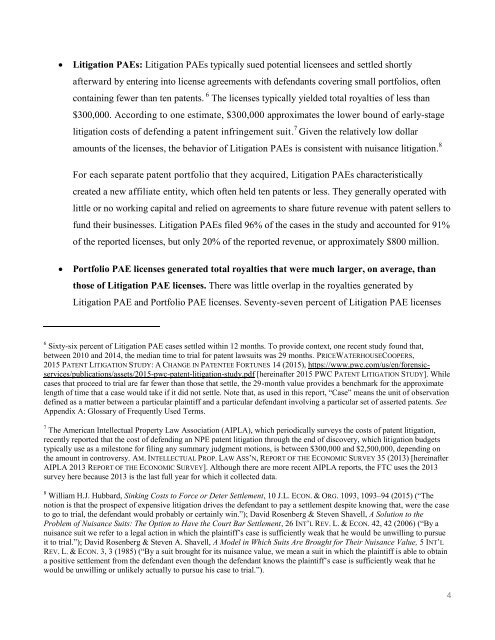Create successful ePaper yourself
Turn your PDF publications into a flip-book with our unique Google optimized e-Paper software.
Litigation PAEs: Litigation PAEs typically sued potential licensees and settled shortly<br />
afterward by entering into license agreements with defendants covering small portfolios, often<br />
containing fewer than ten patents. 6 The licenses typically yielded total royalties of less than<br />
$300,000. According to one estimate, $300,000 approximates the lower bound of early-stage<br />
litigation costs of defending a patent infringement suit. 7 Given the relatively low dollar<br />
amounts of the licenses, the behavior of Litigation PAEs is consistent with nuisance litigation. 8<br />
For each separate patent portfolio that they acquired, Litigation PAEs characteristically<br />
created a new affiliate entity, which often held ten patents or less. They generally operated with<br />
little or no working capital and relied on agreements to share future revenue with patent sellers to<br />
fund their businesses. Litigation PAEs filed 96% of the cases in the study and accounted for 91%<br />
of the reported licenses, but only 20% of the reported revenue, or approximately $800 million.<br />
<br />
Portfolio PAE licenses generated total royalties that were much larger, on average, than<br />
those of Litigation PAE licenses. There was little overlap in the royalties generated by<br />
Litigation PAE and Portfolio PAE licenses. Seventy-seven percent of Litigation PAE licenses<br />
6<br />
Sixty-six percent of Litigation PAE cases settled within 12 months. To provide context, one recent study found that,<br />
between 2010 and 2014, the median time to trial for patent lawsuits was 29 months. PRICEWATERHOUSECOOPERS,<br />
2015 PATENT LITIGATION STUDY: A CHANGE IN PATENTEE FORTUNES 14 (2015), https://www.pwc.com/us/en/forensicservices/publications/assets/2015-pwc-patent-litigation-study.pdf<br />
[hereinafter 2015 PWC PATENT LITIGATION STUDY]. While<br />
cases that proceed to trial are far fewer than those that settle, the 29-month value provides a benchmark for the approximate<br />
length of time that a case would take if it did not settle. Note that, as used in this report, “Case” means the unit of observation<br />
defined as a matter between a particular plaintiff and a particular defendant involving a particular set of asserted patents. See<br />
Appendix A: Glossary of Frequently Used Terms.<br />
7<br />
The American Intellectual Property Law Association (AIPLA), which periodically surveys the costs of patent litigation,<br />
recently reported that the cost of defending an NPE patent litigation through the end of discovery, which litigation budgets<br />
typically use as a milestone for filing any summary judgment motions, is between $300,000 and $2,500,000, depending on<br />
the amount in controversy. AM. INTELLECTUAL PROP. LAW ASS’N, REPORT OF THE ECONOMIC SURVEY 35 (2013) [hereinafter<br />
AIPLA 2013 REPORT OF THE ECONOMIC SURVEY]. Although there are more recent AIPLA reports, the FTC uses the 2013<br />
survey here because 2013 is the last full year for which it collected data.<br />
8<br />
William H.J. Hubbard, Sinking Costs to Force or Deter Settlement, 10 J.L. ECON. & ORG. 1093, 1093–94 (2015) (“The<br />
notion is that the prospect of expensive litigation drives the defendant to pay a settlement despite knowing that, were the case<br />
to go to trial, the defendant would probably or certainly win.”); David Rosenberg & Steven Shavell, A Solution to the<br />
Problem of Nuisance Suits: The Option to Have the Court Bar Settlement, 26 INT’L REV. L. & ECON. 42, 42 (2006) (“By a<br />
nuisance suit we refer to a legal action in which the plaintiff’s case is sufficiently weak that he would be unwilling to pursue<br />
it to trial.”); David Rosenberg & Steven A. Shavell, A Model in Which Suits Are Brought for Their Nuisance Value, 5 INT’L<br />
REV. L. & ECON. 3, 3 (1985) (“By a suit brought for its nuisance value, we mean a suit in which the plaintiff is able to obtain<br />
a positive settlement from the defendant even though the defendant knows the plaintiff’s case is sufficiently weak that he<br />
would be unwilling or unlikely actually to pursue his case to trial.”).<br />
4


